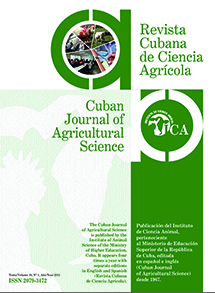Inoculation of substrate with lactic acid bacteria for the development of Moringa oleifera Lam plantlets
Main Article Content
Abstract
However, the root length was higher in LABP and LABB with respect to the rest of treatments (P < 0.001). In the number of leaves, a positive effect was obtained initially, favoring the use of LAB with respect to the control (P < 0.001), with no statistical effect on insertion of the first branch (P > 0.05). It is concluded that the use of inoculum of lactic bacteria from the fermentation with pumpkin, banana and papaya resulted in an ecotechnology that promotes the emergence and development of Moringa oleifera plantlets.
Key words: forage, growth, nursery, LAB, trees
Article Details
Those authors that have publications with this journal accept the following terms:
1. They will retain their copyright and guarantee the journal the right of first publication of their work, which will be simultaneously subject to the License Creative Commons Attribution-NonCommercial 4.0 International (CC BY-NC 4.0) that allows third parties to share the work whenever its author is indicated and its first publication this journal. Under this license the author will be free of:
- Share — copy and redistribute the material in any medium or format
- Adapt — remix, transform, and build upon the material
- The licensor cannot revoke these freedoms as long as you follow the license terms.
Under the following terms:
- Attribution — You must give appropriate credit, provide a link to the license, and indicate if changes were made. You may do so in any reasonable manner, but not in any way that suggests the licensor endorses you or your use.
- NonCommercial — You may not use the material for commercial purposes.
- No additional restrictions — You may not apply legal terms or technological measures that legally restrict others from doing anything the license permits.
2. The authors may adopt other non-exclusive license agreements to distribute the published version of the work (e.g., deposit it in an institutional telematics file or publish it in a monographic volume) whenever the initial publication is indicated in this journal.
3. The authors are allowed and recommended disseminating their work through the Internet (e.g. in institutional telematics archives or on their website) before and during the submission process, which can produce interesting exchanges and increase the citations of the published work. (See the Effect of open access).
